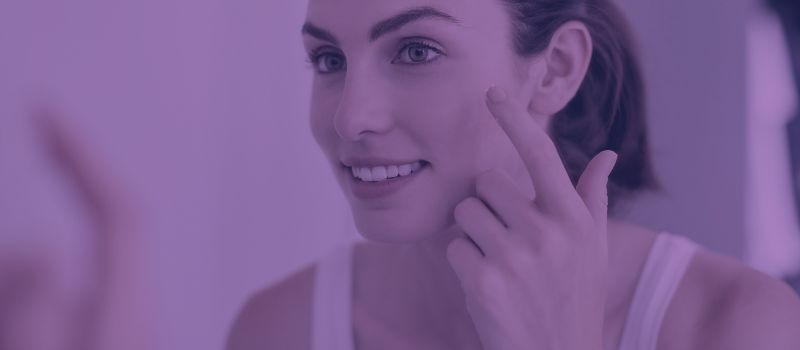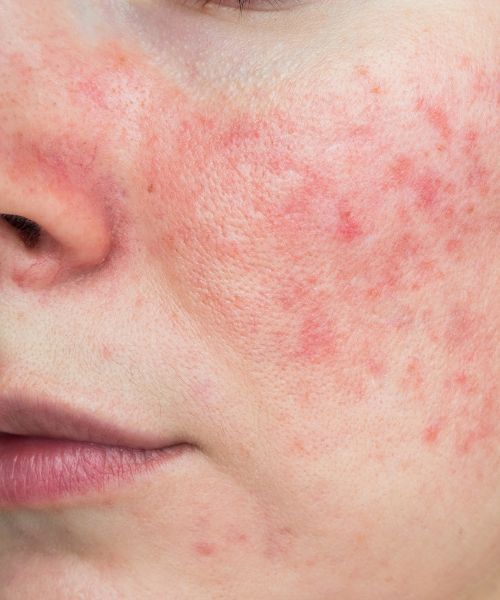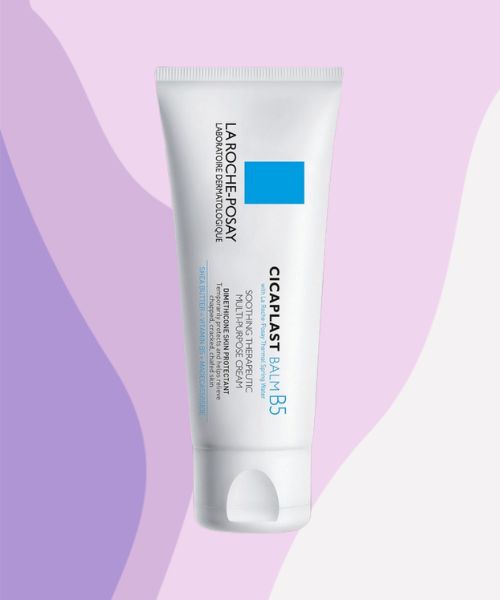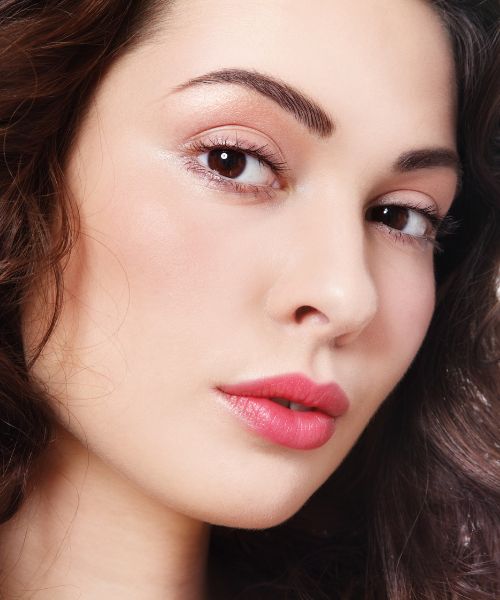If you’ve already been to my website, you know that I love the Cicaplast Baume B5.
I discovered this product while experimenting with tretinoin a few years ago, and it’s been a staple in my skincare routine ever since, even though my routine has drastically changed since then.
So, is the La Roche-Posay Cicaplast Baume B5 good for rosacea? The short answer is yes!
Cicaplast Baume B5 is loaded with soothing, calming, and repairing ingredients that can make a difference for someone with rosacea.
And while that’s pretty much the short answer, in this article, I will talk more about rosacea, what it is, how to deal with its symptoms, and how implementing the Cicaplast Baume B5 can help.

Rosacea: Overview & Symptoms

Rosacea is a chronic inflammatory skin condition that manifests on the skin as red spots or a rash that can be pustular or look like inflamed “blind” pimples.
Rosacea can happen to anyone; however, it has been observed that this inflammatory condition is most prevalent among:
- Middle-aged or older adults.
- Women.
- People with fair skin.
- People with a family history of rosacea.
Most people dealing with rosacea only experience some symptoms, and the patterns can vary from individual to individual.
And because the condition is chronic, rosacea often cycles between flare-ups and periods of remission (lack of symptoms.)
The most common symptoms of rosacea include:
Facial redness: This may start as a tendency to flush or blush, but over time, redness may persist for longer periods. It is sometimes accompanied by tingling or burning, and the reddened skin may turn rough and scaly. It commonly spreads across the cheeks and nose and takes a butterfly shape.
Rash: Areas of facial redness can develop red or pus-filled bumps and pimples that resemble acne.
Visible blood vessels: These typically appear as thin red lines on the cheeks and nose due to the dilation of small blood vessels below the skin surface.
Skin thickening: The skin may thicken, especially on the nose, giving the nose an enlarged and bulbous appearance. This is one of the more severe symptoms, and it is commonly observed in men who experience rosacea but rarely in women.
Eye irritation: In ocular rosacea, the eyes become sore, red, itchy, watery, or dry. They may feel gritty or as if there is something in them, such as an eyelash.
Sometimes rosacea follows a progression, going from temporary flushing of the nose and cheeks to longer-lasting flushing, then to the appearance of a rash and small blood vessels beneath the skin.
If left untreated, the skin may thicken and enlarge, leading to firm, red bumps, especially on the nose.
The symptoms typically come and go, with many people reporting that certain factors, such as spending time in the sun, eating spicy foods, drinking alcohol, or experiencing emotional stress, bring them on.
There is no cure for rosacea, but treatment can keep it under control.
Treatment choice will depend on the symptoms and usually includes a combination of self-help measures, topical ointments, and oral or systemic medication.
READ: What is Acne Rosacea?
Is La Roche-Posay Cicaplast Baume B5 Good for Rosacea?

La Roche-Posay’s Cicaplast Baume B5 is a multi-purpose balm that can be used for various skin conditions, including rosacea.
This balm has a thick, creamy consistency that melts into the skin easily and contains a blend of hydrating, moisturizing, and soothing ingredients that calm and protect the skin.
Some of the main ones include softening shea butter, hydrating glycerin, soothing and repairing panthenol, nourishing magnesium, anti-inflammatory zinc, as well as Madecassoside, which is one of the four main compounds in the plant extract Centella Asiatica, a soothing and repairing agent that helps strengthen the skin barrier.
The Cicaplast Baume B5 is also non-comedogenic, and although it’s quite thick and heavy, it doesn’t contain ingredients that can clog your pores and cause your skin to break out on top of rosacea.
The best way to use it is by warming it up between your fingertips until it melts and pressing it into the skin rather than rubbing it like a regular moisturizer.
Once applied to the areas where you are experiencing rosacea symptoms, you will feel immediate relief as the inflammation and redness start to subside.
With regular use, you will also notice that your skin feels softer, smoother, and more hydrated and that the overall appearance of your skin improves as well.
So, while the Cicaplast Baume B5 won’t necessarily treat or get rid of rosacea, it can noticeably improve the symptoms, soothe and protect the skin, and repair the skin barrier, which is often damaged in those dealing with this inflammatory condition.
This is more important than you might think because a strengthened skin barrier is the foundation of healthy skin, and once you have that, you will find it easier to manage rosacea and achieve and maintain clear skin.
A strong and healthy skin barrier will also withstand further flare-ups and make your skin better able to not react in inflamed bumps and rashes to the triggers that can cause them.
Alternative Rosacea Treatments

As I mentioned, rosacea is a chronic condition that can only be maintained but not fully treated.
However, before you feel completely defeated, know that proper maintenance can help you keep your rosacea under control and prevent flare-ups and symptoms.
It’s even possible to not experience them for months and even years if you’re doing everything right!
But, because doing everything right is very subjective regarding skincare, as every skin is different, I’ll give you some general tips to help you keep your rosacea under control.
From there, you can create a skin diary and keep track of what works for you and what doesn’t. This is how you can recognize triggers and avoid them in the future.
Here are some of the best treatment options for rosacea symptoms:
Niacinamide
Niacinamide is a form of vitamin B3 that’s water-soluble and often used in skincare products because it has numerous benefits for the skin.
It’s an antioxidant that can help reduce inflammation, redness, and swelling, and it’s also been shown to help repair the skin barrier.
All of these properties make niacinamide an excellent ingredient for those dealing with rosacea, as it can help soothe the symptoms and calm the skin.
It’s also non-irritating, which is another big plus, and you can find it in both serums and moisturizers.
However, to make sure that your skin won’t react to this ingredient, opt for a product with a low concentration of niacinamide of 3-5%.
Azelaic Acid
Azelaic acid is another ingredient that can help reduce inflammation, redness, and swelling that comes with rosacea.
It’s a naturally occurring compound found in wheat and rye that has antimicrobial properties, so it can also help with acne, as these two conditions often travel together and can be mistaken for one another.
Azelaic acid is often prescribed to those dealing with rosacea in concentrations of up to 20%; however, starting with an over-the-counter product containing 10% or less can be a better beginner option.
Sulfur
Sulfur is a natural element and has long been used to treat acne and other skin conditions. It works by helping the skin shed dead skin cells, unclog pores, and absorb excess oil.
Sulfur can also help reduce the redness and swelling that comes with rosacea, as it’s a natural anti-inflammatory agent.
You can find this ingredient in spot treatments, face masks, and cleansers; however, because it can be drying, it’s important to use it only on the areas that are affected by rosacea and follow it up with a good moisturizer.
Oral Antibiotics
This is my least favorite option, but oral antibiotics can work to decrease symptoms of rosacea.
However, it’s definitely better to avoid them if you can, as antibiotics are a short-term therapy and can’t be used for longer than 3-6 months.
After stopping antibiotics, rosacea symptoms can come back with a vengeance, and you can also develop antibiotic resistance, which is when bacteria become resistant to the effects of antibiotics.
Additionally, antibiotics are notorious for causing gut issues and yeast infections due to the disturbance of the microbiome, so it’s really not worth it, in my opinion, even though they can provide short-term relief.
If your doctor does prescribe them to you, make sure to take a probiotic and eat a diet rich in fermented foods to help offset the potential side effects. On the other hand, you can always talk to your doctor and ask them for an alternative treatment option.
Diet Modifications
This is probably one of the best ways to help control rosacea symptoms, as what you eat can significantly impact your skin.
Certain foods and drinks can trigger inflammation and worsen rosacea symptoms, so it’s important to be aware of these triggers and avoid them.
Some common triggers include:
- Alcohol
- Spicy foods
- Hot drinks
- Caffeine
- Dairy
- Sugar
Of course, everyone’s triggers are different, so you might need some trial and error to see what works for you.
In general, though, a diet rich in anti-inflammatory foods like fruits, vegetables, healthy fats, and omega-3s can help reduce rosacea symptoms.
Additionally, staying hydrated by drinking plenty of water is crucial, as dehydration can make rosacea worse.
Finally, probiotics are also beneficial as they can help improve gut health, which is often a problem for those with rosacea.
Living with rosacea will require tweaking and changing many aspects of your daily life, from the cosmetics you use to the foods you eat and the daily activities you partake in.
This is why keeping a diary where you will document any changes in your skin can be helpful can be useful and will prevent you from becoming overwhelmed.

My name is Simone and I am a certified skin specialist. I created this website to teach my readers how to take great care of their skin and I also like to occasionally share my honest opinions on skincare products I’ve tried. You can learn more about me here.
